
TomTom have finally updated their successful RUNNER series of watches with the cunningly named RUNNER 2 series. There is a TomTom SPARK series which is essentially the same thing.
ESSENTIAL READING: TomTom Runner 3/Spark 3 – Review of Replacement Product
Summary Review
(Here) is a link to a 1 minute review of the Runner 2/SPARK *BUT* for those of you who want LOTS OF detail read on.
The RUNNER 2/SPARK is probably best suited for a runner looking for a well featured and well-priced device that can also support forays into other single sports like cardio classes, cycling or swimming. It supports multiple, single sports but not multi-sport events like triathlon.
That’s a bit boring isn’t it? Everyone does that surely?
Well no! Because..
It does what it does with MUSIC and with a newly designed inbuilt Optical Heart Rate Monitor (oHRM).
It’s obviously an activity tracker as everything seems to be one, we bought a dog last week and that had an activity tracker built into the collar too.
If you fancy an upgrade to your current TomTom you’ll probably buy one, if you love music when exercising you’ll be looking closely at this and wondering about ditching your smartphone. If you think there’s benefits to training by heart rate but just hate chest straps then you’ll be excited by the new oHRM in the TomTom Runner 2/Spark.

The Runner 2/Spark is probably not the best choice for a 5-times-a-week serious runner into their stats nor for the multi-sport triathlete in need of bike functionality. But it will certainly cope to a degree with the rigours of those particular endeavours.
It’s for runners. The clue is in the name.
The detailed review starts by incorporating two links to some of the subject areas that I know a few of you are less interested in – unboxing, setup, configuration and the like. They are included for completeness and, whilst I try to add a little humour to opening a box, it does get VERY difficult. So these are in separate posts/links.
Those of you who are concerned about value for money or in need of specific features or who just want to make sure they are ticking all the research-boxes by getting the opinion of more than just one or two people should read on and discover a little more about the Runner 2/Spark.
Unboxing, Box Contents, Weights & Dimensions
This entire section is covered as a detailed, separate post/page which you can find (here). It’s not that interesting.

Installation, Configuration & Pairing.
This entire section is covered as a detailed, separate post/page which you can find (here). It’s a little bit more interesting than the unboxing section but less interesting than watching paint dry (when you’ve bought one come back and have a look).
Other TomTom Runner 2/Spark Variants

I reviewed the TomTom Runner 2 Cardio + Music. There is also a TomTom Spark Cardio + Music. From what I understand they are the same but the SPARK just has a more comfortable 24×7 strap.
There are also variants with or without headphones.
There are also variants with or without Cardio (that’s the built-in oHRM). You can use your existing Bluetooth chest strap or wrist band for this model.
There are also variants with or without music. ie an MP3/AAC player.
Vaguely confusing I suppose, but now you know. Maybe this helps:
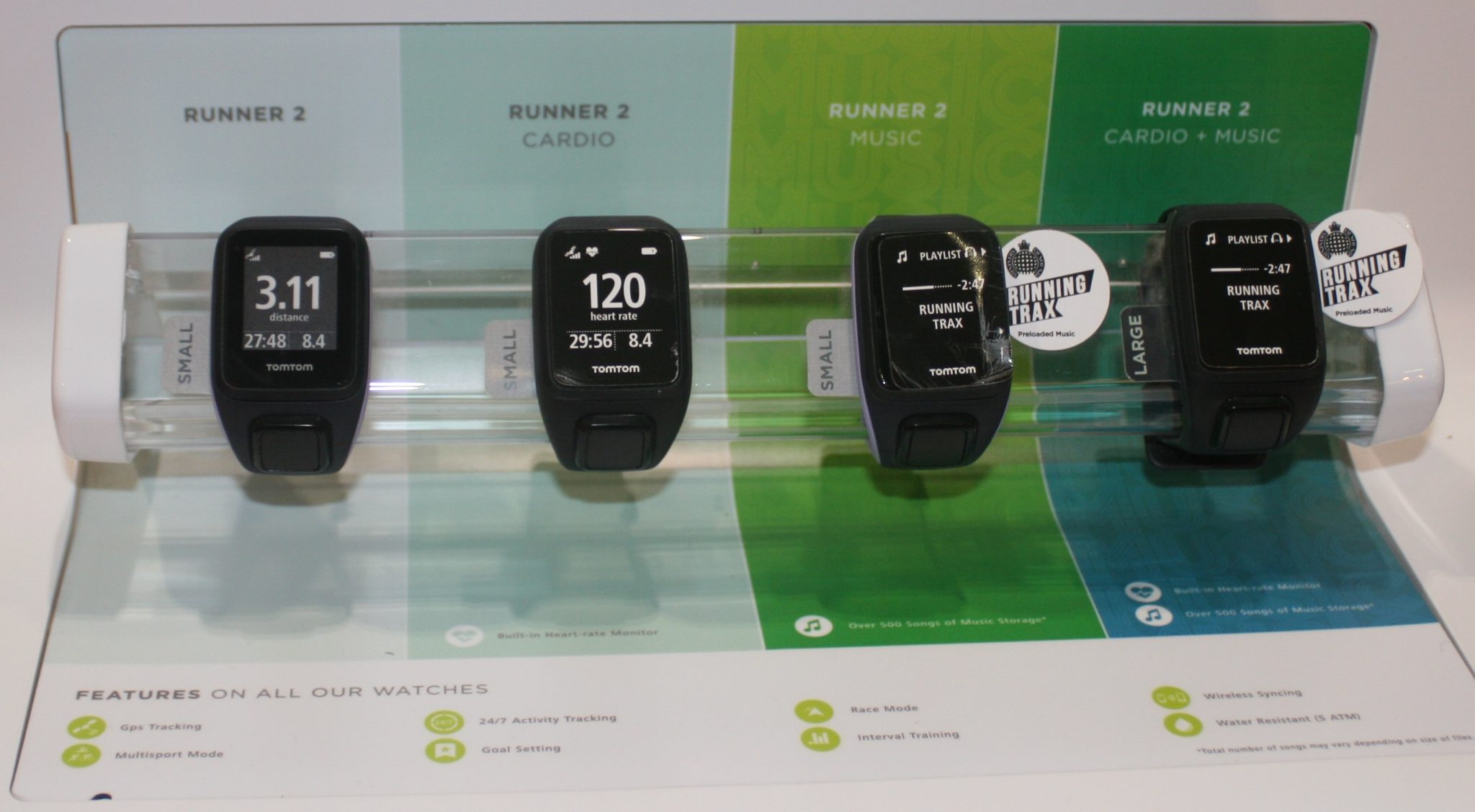
First Time Usage
You can just get running with the watch out of the box or you can arrive at that point after having customised all the various software bits and charging it up.
Apart from the hand-cover sensor (you put your hand over the display and the backlight comes on) there is just one large control button below the screen. It’s intuitive to use and you press up/down/left or right.

Generally you press it to the right to GO and do stuff. So press RIGHT and you get a list of pre-loaded sport profiles. You choose running and it asks you to wait while it finds the GPS.
Finding the GPS the very first time might be slow. Once the device knows where you are it loads up satellites MUCH faster on subsequent occasions using its assisted-GPS (a-GPS) feature. a-GPS relies on you connecting to the internet in some way from time to time for it to know where the satellites are that week.
Once you have chosen to run you are presented with this. This wasn’t my FIRST run and my previous kind of run was a zone-based one, as shown.
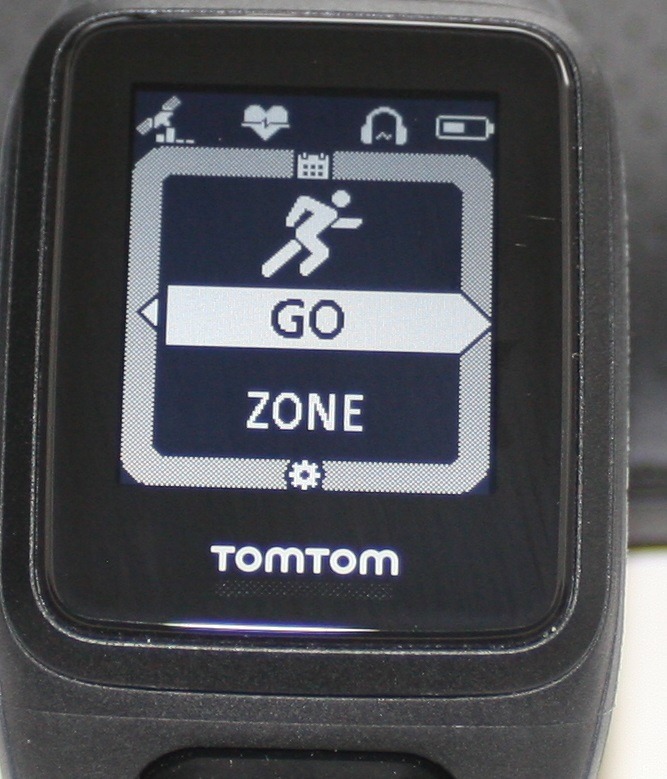
- GO LEFT: Takes you back from whence you came
- GO UP: Would take you to your history or if you arrive at this screen at the end of a session it would go up to show a summary of your session.
- GO RIGHT: gets you running.
- GO DOWN: Let’s you to define your run.

You would define your run in many of these ways
- The playlists you are going to listen to
- The kinds of extra data you want showing on the screen (bottom left and bottom right panel of the main running screen)
- The kind of run training – race, interval, laps, intervals, goals or ‘just run/none’.
Once you have made your mind up you will get an audio alert: ‘I’m Ready’ or ‘Ready to go’. And so you are.
This is not the way I typically use a running watch. However I have to say that it is a nice and easy-to-use interface. It makes sense. Sometimes when you are exposed to a new piece of kit the interface is not intuitive. The Runner 2/Spark IS intuitive.
There are LOTS of screen on the Runner 2/Spark. I pity anyone who wants to comprehensively review every one. Here is a flavour of the sort of thing you can expect:
Accuracy – Distance
Once you’re running it’s nice to have some degree of confidence that what you are being shown is at least a vague reflection on reality. My first test was with another accurate watch on the other wrist. They both ‘beeped’ at roughly the same time on the autolaps. So that was a good start.
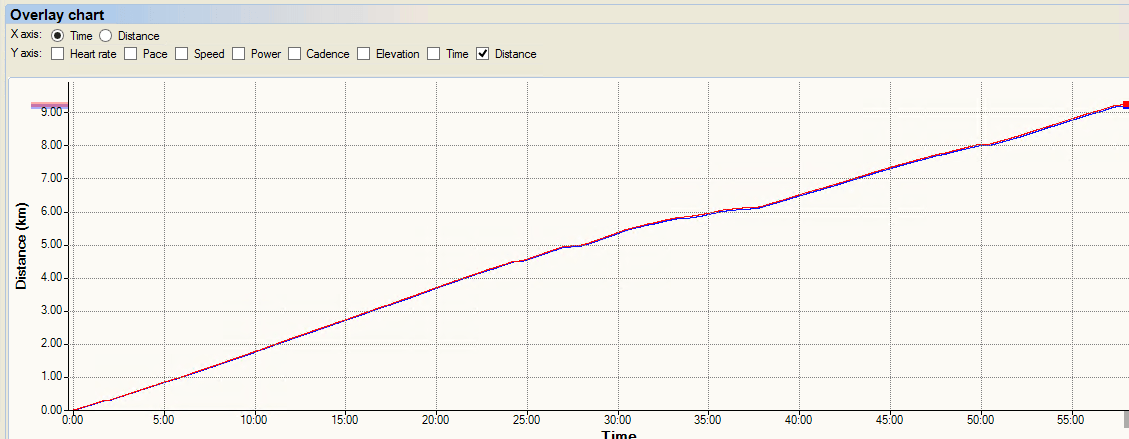
On a 10km run the TomTom Runner 2 under-reported the distance on the other watch by 50m. Or, put another way, the other watch over-reported by 50m! This was over a VERY windy/curved route with significant amounts of tree cover. Over a more exposed/open and straight 5k the reporting was out between the two units by about 30m.
As the above chart shows, they track distance very closely.
A more detailed, but non-conclusive, analysis found that most of the error came at the start and end of the run at slower speeds. Strange.
Accuracy – Tracking
You can judge these two tracks yourself. Possibly the TomTom is better.
Accuracy – Speed/Pace
Over 5 runs totalling >25km the Garmin and TomTom were the same average speed +/- 0.1km/h for each run.
Accuracy – Instant Pace
Displayed Instant pace will probably not be recorded into the file for TomTom. For the Garmin it is not. I will have to report back on this later. Though I’ve yet to find a current watch that will properly report GPS-instant pace correctly; so don’t hold your breath for the TomTom being the first of the modern crop!
Heart Rate – Steady
Here we compare the TomTom (Blue) to a Garmin+4iiii Viiiiva V100 HRM (Red). The 4iiii may have some smoothing occurring in the HRM (it was NOT set on the Garmin receiving device as SMART recording).
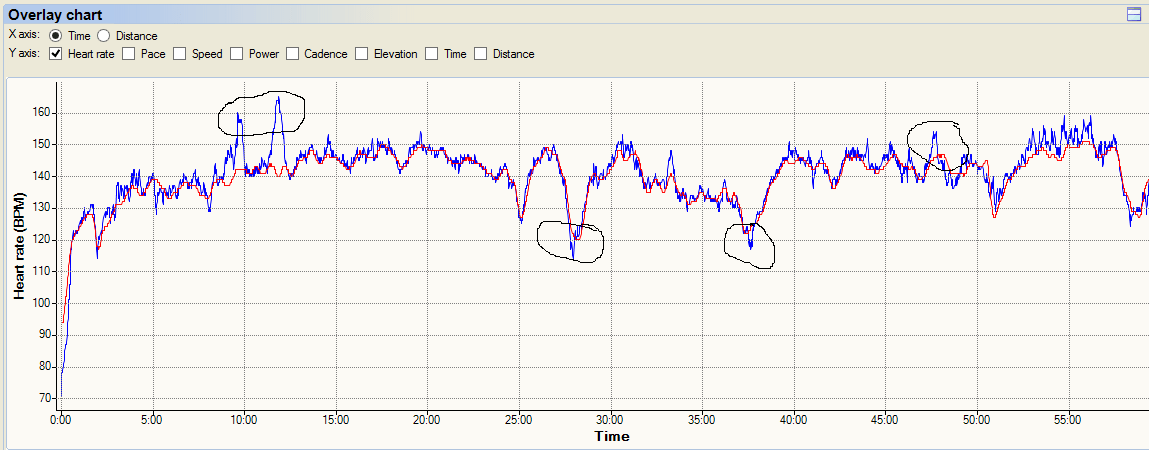
This was an easy run, probably with no sweat to affect the results. I’m not sure what the first two TomTom spikes are. They may have coincided with me stopping to talk to someone to ask directions. They are certainly inaccurate readings. The final small spike (highlighted) was when I was walking through some long grass to avoid thistles and cursing!
The highlighted troughs show some variation but nothing too noteworthy IMO.
On that basis the TomTom’s oHRM looks eminently usable for long slow runs. It was the same picture on similar runs. That shouldn’t come as too much of a surprise as many competing technologies perform well at this kind of level of effort.
Heart Rate – Tempo/Threshold/VO2max
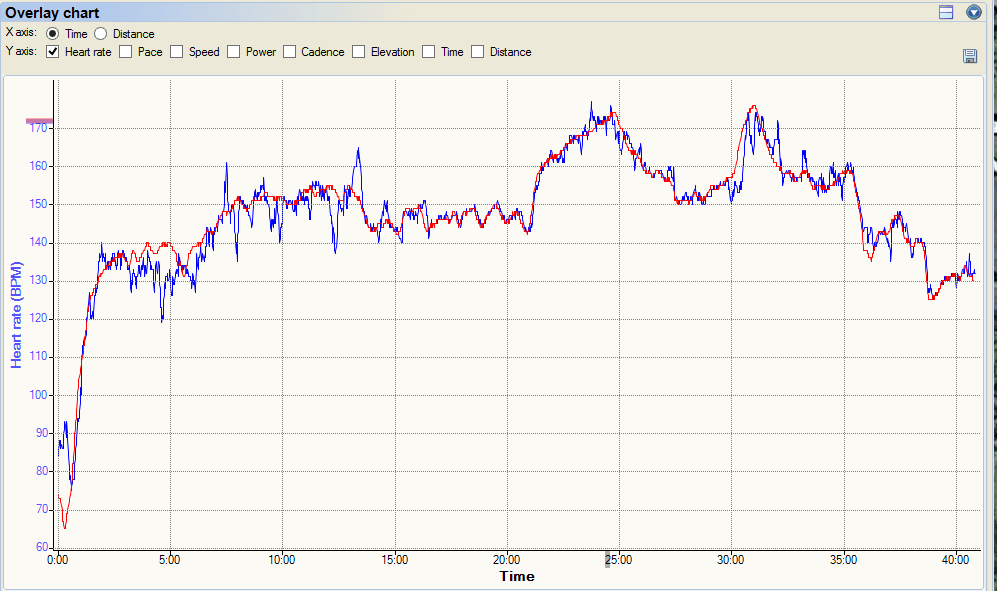
So this was a relatively fast 1km and then a fast 1minute with HR going into Z5, peaking at 173/174bpm. If anything it looks like the TomTom’s HR reading improves as the more strenuous stuff starts to happen at 15:00 minutes.
As the 1 minute hard bit happens at 31:00 minutes there is a slight delay as the TomTom plays catch-up but I reckon that’s pretty good performance on the whole.
What do you think?
To help with the thought process have a look at the previous best performing oHRM at high HR levels – the Scosche RHYTHM. I’d say the TomTom is not quite as good. But not too far off. So, 2nd best ever still with some wiggle room to tweak the algorithm and improve it.

Battery
The battery life may be a slight cause for concern in this watch. You need to understand what you are buying.
When comparing it to other devices you need to make sure that you are comparing like with like, not forgetting that the battery will be reduced when you play music or use GPS or use the oHRM or use the voice coach or use alerts or use additional sensors or have a screen to power or use the backlight on the screen.
So if your friend has a watch whose battery lasts for 18 hours of solely GPS-enabled running your TomTom will compare MUCH less favourably with all the bells and whistles turned on.
The MIO Link optical wrist band, for example, is 10 hours. The optical Garmin 225 is about 7 hours. The Mio hasn’t got a screen and the Garmin doesn’t play music.
From what I can ascertain these are the real normal-use battery lives: 5 hours battery life for GPS+HR+Music, 9 for GPS/HR, 11 for GPS only. 2-3 weeks for activity tracker/watch only.
The TomTom’s battery IS GOOD compared to like-for-like competition.
Less-normal but still real-life usage scenarios may significantly shorten it eg running with the light on.
Charging the device requires TomTom’s USB cradle. I found it very awkward to attach the cradle to the device and would have preferred a generic micro-USB cable. Although that would have made waterproofing more difficult.
Special Features – Optical Heart Rate
 The optical heart rate unit from TomTom is a special feature. The previous iteration of the watch used the MIO sensor which was one of the best ones a couple of years ago.
The optical heart rate unit from TomTom is a special feature. The previous iteration of the watch used the MIO sensor which was one of the best ones a couple of years ago.
This one comes from a South African company called LifeQ.com and their measurement solution is validated (here). Their tests seem to show some variation from an accurate ECG when there are sudden ambient temperature changes. Their tests do assess fast cycling but not fast running and appear to extend accurate heart rates up to the high 190s bpm. Looking at other papers from them they suggest the ability to read HRV data, although that is less accurate on darker skinned people.
LifeQ integrate smaller components to enable them to specify the complete sensor and metrics behind interpreting and using the data.
There’s more stuff (here) that I wrote a while back on the oHRM devices in other sports watches if you are interested.
One distinctive element of the LifeQ design is shown in the image below where you should be able to make out multiple, mini sensor/lights in each of the 3x square glass areas of the complete sensor. More sensors, more colours of light and a large sensor area all make for the groundings of a good sensor.
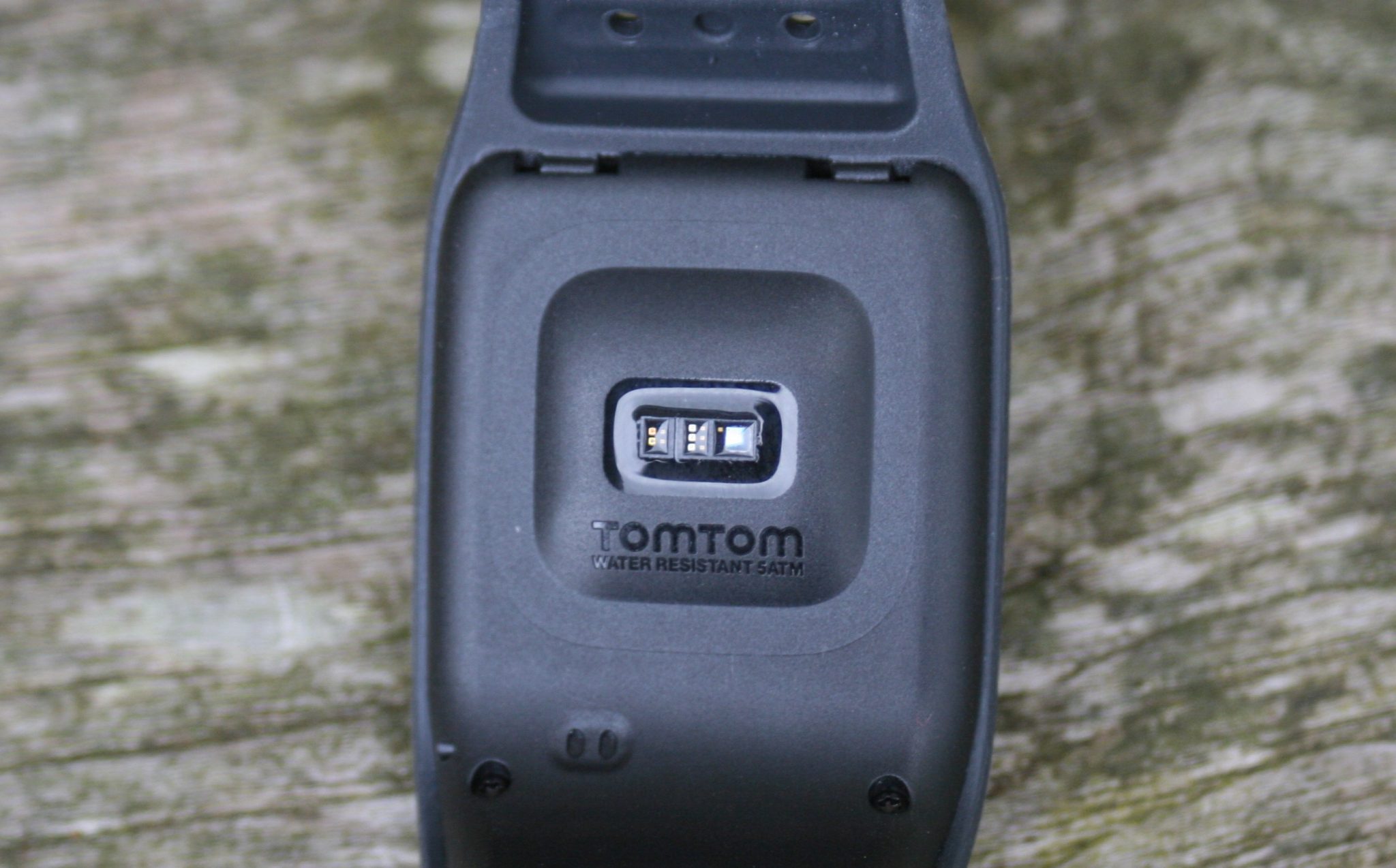
Note: The optical HR signal is NOT re-broadcast for other devices to receive.
Special Features – Swimming
The device is waterproof and is designed for swimming (5 ATM, 40m). There is automatic detection of the number of strokes and detection of when you turn at the end of a lap. With this info the TomTom determines how far you swim as well as incorporating SWOLF metrics to show your swimming efficiency. There is not HR when swimming.
If you just wanted to record your HR when swimming I imagine you would get reasonable results by tricking the device and telling it that you are doing indoor running and then it would turn the oHRM on.
With a correctly set pool size the TomTom recorded 2.3km whereas the reality was 1.5km. I have a reasonable swim stroke and usually push off hard from the ends of a pool. So that’s a big discrepancy.
Special Features – Cycling
Earlier sections touch on the ability to incorporate bike cadence and speed data. With this you have the making of a tidy little bike computer. Sure it hasn’t got the bells and whistles of the fancy cycling computers on the market but for most people those are not required.
The basic speed/cadence/GPS functionality that is provided is fine for the purpose for which it is intended.
Special Features – Music
Pairing with non-TomTom headphones was fine and easy. Simply dragging and dropping albums onto the device’s memory was easy. The TomTom mySports Connect Application is able to scan your Windows Media Player and the iTunes library and you can select tracks to be transferred using the Connect software.
You can store approximately 500 songs or 3Gb. There are some quite specific file types that are supported. Generally it is MP3, MPEG and AAC up to 320kbps @48KHz.

The music is controlled from your headphones’ controller and not the watch. Although you can select specific playlists for a specific exercise session on the watch.
Indeed my suggestion is to work solely on playlists as the Runner 2/Spark effectively does not recognise any form of album/artist/song file structure that you might drag onto it. It works either alphabetically or by playlist order.
The quality is awesome. I use 320kbps MP3s ripped from a re-mastered source on a high-end system. I used high-end Jabra earbuds to convert the digital to the analogue sound that we hear.
Digital is digital! The source is the source.
Rubbish source for the rip and rubbish headphones will sound rubbish. Nothing to do with the TomTom!
So, when I say the quality is awesome I mean the non-TomTom bits that I used were awesome. The TomTom does virtually nothing that can affect the quality except in the persistence of the Bluetooth signal…
At times I noted quite frequent drop outs ie every minute. This was NOT when running but when my watch (left hand) was by my side on the opposite side to the Jabra’s controller (right hand). Apparently having both on the same side helps. Indeed sitting down now with my hands in front of me typing it’s 100% fine.
There are no links to subscription services that stream music…think about it!
Special Features – Voice Coach
If you have vibration alerts or audible beeps or buzzes on your current watch then TomTom’s Voice Coach is exactly the same except a piece of pre-recorded audio instruction is played to you though the headphone at the appropriate time. There are also a few ‘Get-Ready’ generic-type messages.
It’s rudimentary coaching and fine if you like that sort of thing. I don’t, but that’s me and you are you.
Special Features – Activity Tracker
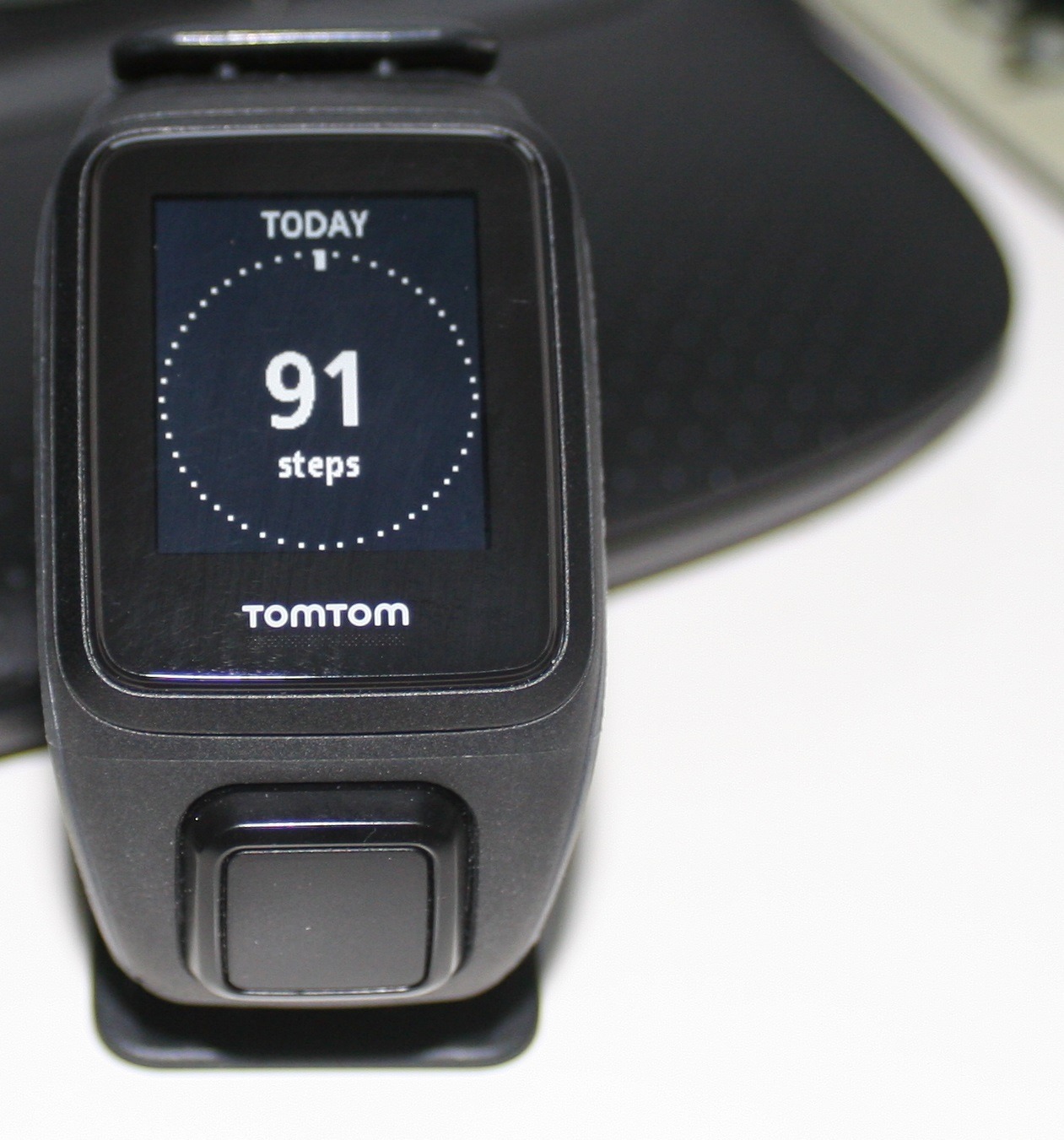
Over the last year I’ve grown quite cynical about the activity tracker market and activity trackers in general. Having gone through phases of trying to compare 5 devices over 1000 steps I’ve generally given up. They are all different and probably all wrong but to differing degrees.
The 91 steps on the right probably reflects my post-breakfast, early morning activity. There’s been lots of wear and tear on my fingers and bum but little on the soles of my shoes.
After a couple of days of usage it seems fairly consistent, coming in at 6000 or so steps per day. Probably about right when compared to itself the previous day. And that is what you want to do. Track your activity and how it should hopefully trend upwards over time.
The 91 steps image indicates the simplicity of the presentation of the activity data in general. It’s quick and to the point, showing the various levels of weekly/monthly summary. You’re a runner! That’s why you bought this watch! The number of steps and analysing it is irrelevant to YOU. Simple high level figures are perfect.
I was a little disappointed with the sleep tracker when I found out it was solely motion based. Apparently TomTom plan to eventually turn on periodic oHRM measurements overnight to properly track your sleep cycles. With the promise of HRV enablement as part of that, from the LifeQ sensor array, this sort of analysis COULD get quite clever down the line. Let’s see.
Who would buy this?
I can see where the TomTom Runner 2 is coming from. It’s targeting a lot of people with a sound, and generally well-priced, series of offerings for all of them.
If you’re a recreational runner or a getting-serious runner (parkrunner) then the Runner 2 will do very nicely, thank you very much.
If you don’t like chest straps then, again, the Runner 2 bodes well for you.
If you like exercising with music and would prefer to lug around only one device on your arms then the Runner 2 stands out as a fairly obvious choice.
Men and women alike will both buy this for the design and functionality. Some women will buy it just because of the oHRM but other women may avoid it as they might want a slightly smaller screen.
Summary
This is a GOOD PRODUCT.
It’s not for me personally but you’ll be relieved to know that you are not me!
The GPS and distance accuracy look good. The jury is out on instant pace, which is a niche need – admittedly important for half-serious runners.
The music playback is generally good and the music playlist functionality is fine but necessarily basic.
The heart rate accuracy looks generally very good at easy-to-medium levels. (I will update when better tested at higher levels).
The activity tracker is functional and is fit-for-that-purpose.
The online software is a bit rubbish for more serious analytical types (as some runners are). However it’s fine as a basic app/web solution. Apparently it will be improved dramatically in an impending release.
In any case you can send your data to other web services such as STRAVA, which IS good.
The device looks good enough to wear 😉 Although I wish the watch-display could be changed.
The Alternatives.
If you want music and oHRM then the only real alternative is the ageing adidas miCoach at US$300/GBP200 rrp. That’s a good product but a bit bulkier. I’ve not had a play with the Garmin 225 yet but that’s a non-Music equivalent for you at US$300/GBP200 rrp. You could go down the very bulky smartphone route but that must get awkward in cardio classes and you would have to purchase an app and a HRM such as the Scosche RHTHM or MIO Link.
If you want a low-end running-only watch then, in my opinion, the Polar M400 stands out as the winner with a good web data platform for runners. BUT the Polar M400 has neither oHRM nor music.
Support
The online forum delivers quick responses to issues raised.
Here is the manual.
Price (rrp)
The pre-order prices are shown below. It looks like good pricing levels to me – they have it about right. Links are in the table below.
- TomTom Runner 2 GPS Fitness Watch £109.99
- TomTom Runner 2 Cardio GPS Fitness Watch £149.99
- TomTom Runner 2 Music GPS Fitness Watch £149.99
- TomTom Runner 2 Cardio + Music GPS Fitness Watch £189.99
- TomTom Runner 2 Music GPS Fitness Watch + Bluetooth® Headphones £189.99
- TomTom Runner 2 Cardio + Music GPS Fitness Watch + Bluetooth® Headphones £229.99
| Black Friday 2015 | Amazon | UK | Amazon2 | USA |
| Adidas MiCoach Smart Run | £199.99 | Link | $249.99 | Link |
| Bryton | n/a | n/a | ||
| Epson SF-810 | £201.58 | Link | $189.00 | Link |
| Epson SF-710 | £130.00 | Link | $225.00 | Link |
| Epson SF-510 | £110.00 | Link | $252.27 | Link |
| Epson SF-310 | £89.99 | Link | $195.13 | Link |
| Fitbit Charge HR | £75.00 | Link | $140.18 | Link |
| Garmin Edge 1000 Explore (non-bundle) | £345.00 | Link | $449.00 | Link |
| Garmin Edge 1000 | £345.00 | Link | $499.00 | Link |
| Garmin Edge 520 | £176.00 | Link | $299.99 | Link |
| Garmin Edge 510 | £300.00 | Link | $329.99 | Link |
| Garmin Edge 810 | £197.00 | Link | $305.99 | Link |
| Garmin Edge 25 | £100.00 | Link | $160.99 | Link |
| Garmin Edge 20 | £93.50 | Link | $93.54 | Link |
| Garmin Epix | £322.65 | Link | $549.99 | Link |
| Garmin Fenix3 (Sapphire) | £424.00 | Link | $499.99 | Link |
| Garmin Forerunner 25 | TBC | TBC | ||
| Garmin Forerunner 220 | £149.99 | Link | $190.99 | Link |
| Garmin Forerunner 225 | £160.00 | Link | £248.99 | Link |
| Garmin Forerunner 230 | TBC | TBC | ||
| Garmin Forerunner 235 | TBC | TBC | ||
| Garmin Forerunner 620 | £215.00 | Link | $239.99 | Link |
| Garmin Forerunner 630 | TBC | TBC | ||
| Garmin Forerunner 635 | TBC | TBC | ||
| Garmin 910 XT | £174.00 | Link | $201.58 | Link |
| Garmin 920 XT | £272.00 | Link | $499.99 | Link |
| Garmin VivoActive | £177.00 | Link | $149.99 | Link |
| Lezyne Super GPS | £155.00 | Link | $200.00 | Link |
| MIO Cyclo 505HC (Bundle) | £290.00 | Link | $400.56 | Link |
| MIO Cyclo 200 | TBC | TBC | ||
| Mio Alpha 2 | £111.00 | Link | $132.99 | Link |
| Nike+ SportWatch | £208.90 | Link | $149.95 | Link |
| Polar M400 | £115.00 | Link | $181.99 | Link |
| Polar M450 | £105.73 | Link | $135.00 | Link |
| Polar V650 | £194.00 | Link | $239.96 | Link |
| Polar V800 | £242.00 | Link | $336.99 | Link |
| Suunto Ambit 3 PEAK | £211.45 | Link | $335.63 | Link |
| Suunto Ambit 3 Sport | £185.00 | Link | $318.54 | Link |
| Suunto Ambit 2R | £197.21 | Link | $159.00 | Link |
| TomTom Runner 2 | £110.00 | Link | $149.99 | Link |
| TomTom Runner 2 Cardio + Music | £229.99 | Link | $249.99 | Link |
| TomTom MultiSport | £100.00 | Link | $99.99 | Link |
| TomTom MultiSport Cardio | £130.00 | Link | $164.77 | Link |
| TomTom Runner | £69.00 | Link | $89.99 | Link |
| TomTom Runner Cardio | £130.00 | Link | $169.99 | Link |
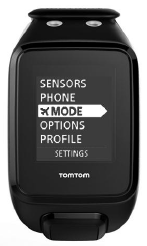

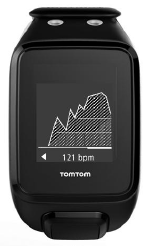



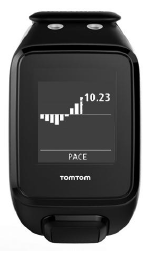






Thank you for your explanations! Just a quick one: how does it compare to the runner 1 cardio model?
A quick response would be: generally improved. I can see no reason to buy the first version if instead you can afford this version. The heart rate sensor is different but the previous one was good too.
Today i was tested new LifeQ HRM sensor on Tomtom Runner2 vs Multisport, take a look:
http://www.kaitbords.lv/wp/tomtom-spark-runner-2-vs-multisport-hrm/